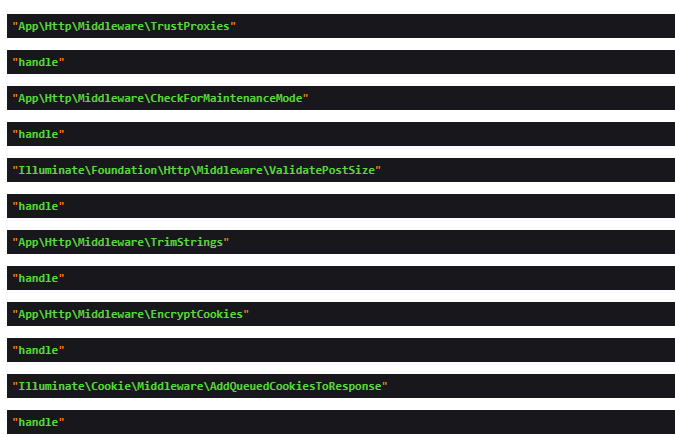Laravel的中间件提供了一种方便的机制过滤进入应用程序的 HTTP 请求,并且Laravel自带了一些中间件包括身份验证、CSRF保护、COOKIE加密解密等,使用非常方便。那么Laravel中“中间件”是怎么实现的,为什么只需要简单修改几个配置就能试中间件生效,中间件的执行顺序又是怎样的呢。出于对这些问题的好奇,我阅读了一下Laravel中间件的实现相关源码。
\Illuminate\Pipeline\Pipeline - 实现中间件的核心类
在介绍Pipeline这个类之前,我们先简单浏览一下Laravel应用程序的生命周期。接下里我一步一步的说明如何实例化Pipeline方法的。
- 在入口文件index.php只有几行代码
$app = require_once __DIR__.'/../bootstrap/app.php';
$kernel = $app->make(Illuminate\Contracts\Http\Kernel::class);
$response = $kernel->handle(
$request = Illuminate\Http\Request::capture()
);
$response->send();
$kernel->terminate($request, $response);
首先实例化了一个Illuminate\Contracts\Http\Kernel,在bootstrap/app.php文件中, Illuminate\Contracts\Http\Kernel接口已经被绑定了App\Http\Kernel类,所以这里的$kernel是一个App\Http\Kernel的对象
bootstrap/app.php
// 此处对Illuminate\Contracts\Http\Kernel进行类绑定
$app->singleton(
Illuminate\Contracts\Http\Kernel::class,
App\Http\Kernel::class
);
$app->singleton(
Illuminate\Contracts\Console\Kernel::class,
App\Console\Kernel::class
);
$app->singleton(
Illuminate\Contracts\Debug\ExceptionHandler::class,
App\Exceptions\Handler::class
);
return $app;
然后接着往下看,调用了Kernel的handel方法,并传入了一个Request对象。
class Kernel implements KernelContract
...
/**
* Handle an incoming HTTP request.
*
* @param \Illuminate\Http\Request $request
* @return \Illuminate\Http\Response
*/
public function handle($request)
{
try {
$request->enableHttpMethodParameterOverride();
$response = $this->sendRequestThroughRouter($request); // sendRequestThroughRouter 方里面实例化了Pipeline
} catch (Exception $e) {
$this->reportException($e);
$response = $this->renderException($request, $e);
} catch (Throwable $e) {
$this->reportException($e = new FatalThrowableError($e));
$response = $this->renderException($request, $e);
}
$this->app['events']->dispatch(
new Events\RequestHandled($request, $response)
);
return $response;
}
/**
* Send the given request through the middleware / router.
*
* @param \Illuminate\Http\Request $request
* @return \Illuminate\Http\Response
*/
protected function sendRequestThroughRouter($request)
{
$this->app->instance('request', $request);
Facade::clearResolvedInstance('request');
$this->bootstrap();
## 这里实例化了Pipeline
return (new Pipeline($this->app))
->send($request)
->through($this->app->shouldSkipMiddleware() ? [] : $this->middleware)
->then($this->dispatchToRouter());
}
...
接下来就到中间件的核心了- Pipeline->then()方法
public function then(Closure $destination)
{
$pipeline = array_reduce(
array_reverse($this->pipes), $this->carry(), $this->prepareDestination($destination)
);
return $pipeline($this->passable);
}
最关键的就是array_reduce(),函数原型:array_reduce ( array callback [, mixed $initial = NULL ] ) : mixed
array_reduce() 将回调函数 callback 迭代地作用到 array 数组中的每一个单元中,从而将数组简化为单一的值。 一般情况下,我们第二个参数返回的是一个基本的数据类型,比如:
$arr = [1, 2, 3, 4, 5];
$sum = array_reduce($arr, function($carry, $item) {
return $carry + $item;
}, 0);
echo $sum;
// 结果为 15
那么如果我们第二个参数放回一个闭包函数会是什么样呢?
$arr = ["item1", "item2", "item3"];
$closure = array_reduce($arr, function ($carry, $item) {
return function () use ($carry, $item) {
dump($item);
if (is_null($carry)) {
return "carry is null " . $item;
}
if($carry instanceof Closure) {
dump($carry());
return $item . '++';
}
};
});
dump("r:");
dump($closure());
结果为:
"r:"
"item3"
"item2"
"item1"
"carry is null item1"
"item2++"
"item3++"
为什么是这个结果呢?array_reduce返回的是一个闭包,只有执行这个闭包函数,里面的逻辑才会执行,所以相当于是把函数暂存起来了,类似于存到了一个栈中。
理解了array_reduce,然后我们看一下Laravel中carry()函数每次都返回了什么,打印一下每次调用的的 pipe 和 method:

输出:

所有carry方法每次都返回了我们配置了的中间件的handle方法,而$pipeline 就是一个由众多handle方法组成的闭包函数,然后执行
return $pipeline($this->passable);
对当前的Request进行过滤。因为后从carry()中返回的方法会被先执行,所以 array_reverse($this->pipes) 对我们的中间件顺序进行了翻转,这样执行的顺序就和我们配置中间件的顺序一致了
以上就是 Laravel 中间件的实现了